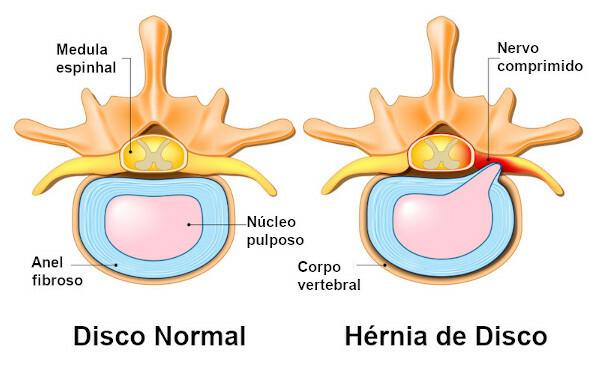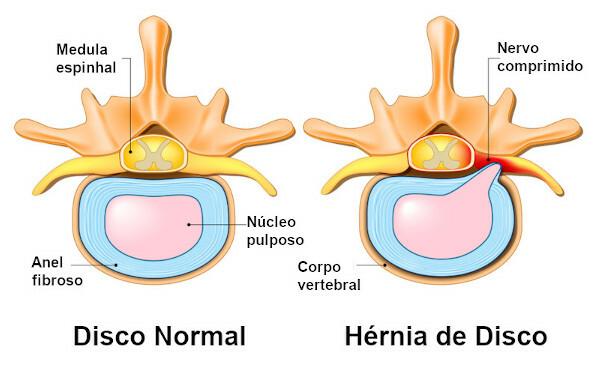THE herniated disc is a health problem that affects the spine, more precisely the intervertebral discs. In this disease, there is the protrusion of the nucleus pulposus through ruptures in the fibers, causing the appearance of a bulge that can press the nearby nervous structures. A herniated disc can cause intense pain radiating to the limb whose nerve root is affected, muscle weakness in the affected limb, and a tingling sensation and numbness in the feet and hands.
Know more:Thoracic arachnoiditis — an inflammation that affects the arachnoid in the region of the thoracic spine
Herniated disc summary
It is a problem that affects the intervertebral disc — cartilaginous structures whose functions are to prevent friction between the vertebrae and cushion impacts.
It negatively impacts an individual's life, causing symptoms such as intense pain radiating to the limbs, muscle weakness in the affected limb and a tingling sensation or numbness in the hands and foot.
Regarding its causes, genetic predisposition stands out.
The diagnosis is made through the analysis of symptoms and tests such as magnetic resonance and radiography.
Surgery is only performed in cases where other methods, such as the use of analgesics, anti-inflammatories, among others, do not work effectively.
What is a herniated disc?
Being a health problem that affects the spine, herniated disc is a degenerative intervertebral disc disease that provokeThe pain, numbness and tingling. To better understand this problem, however, we must know more about the human body anatomy. The vertebral column is formed by several bones called vertebrae, which have a space that forms the vertebral canal, in which the spinal cord is located. spinal cord.
Between each vertebra are the intervertebral discs, structures formed by cartilaginous tissue. Each disc is formed by a more rigid structure called the annulus fibrosus and an inner part of gelatinous consistency called the nucleus pulposus. The intervertebral discs prevent friction between the vertebrae, and its consequent wear, and also act to cushion impacts, resisting the deformations caused by the load.

Over time, it is common for intervertebral discs to wear out, facilitating the formation of herniated discs, a process characterized by the protrusion of the nucleus pulposus through ruptures in the disc. Depending on the amount of herniated material, that is, that came out of its place of origin, compression of the nerve roots may occur, causing the characteristic symptoms of a herniated disc.
The lumbar spine is usually the part most affected by herniated discs. However, other parts of the spine can also show herniation of the intervertebral disc. In general, disc herniation occurs mainly between the fourth and fifth decade of life.
Causes of herniated disc
A herniated disc can have different causes, and, according to the Ministry of Health, some of them are:
the genetic predisposition;
aging;
the lack of physical activities;
O smoking.
Between them, the main cause of the problem is genetic predisposition. It is worth noting, however, that lifting and carrying a lot of weight can also favor the appearance of herniated discs.
Symptoms of a herniated disc
A herniated disc doesn't always cause symptoms, so it Can it be asymptomatic in some situations. When symptoms do arise, however, they can be quite painful and directly affect the individual's quality of life.
The symptoms of a herniated disc vary from one person to another and are directly related to the area where the nerve root has been compressed. So, Thesome of the symptoms are:
severe pain radiating to the limb whose nerve root is affected;
muscle weakness of the affected limb;
tingling sensation or numbness in the hands and feet;
neck stiffness;
difficulty lifting an object or even moving around;
back pains.
The pain caused by a herniated disc may worsen with physical activity or remain constant, but with low intensity. This last situation is more commonly observed in the elderly. In the cervical region, the pain caused by a hernia starts in the neck and radiates to the arms. When it reaches the lumbosacral region, the pain starts in the lower back and radiates to the buttocks, thigh and knee.
Read too: What is and how to treat rheumatoid arthritis?
Diagnosis of herniated disc
For the diagnosis of herniated disc, the doctor will make a analysisthe symptoms presented by the patient and will indicate complementary exams to check the exact location of the lesion and also its size. Among the tests, we can mention magnetic resonance, tomography and radiography.
Herniated disc treatment
There are different treatments for herniated discs, which most of the time guarantee a great improvement to the patient.
More traditional treatments: the doctor will recommend the use of analgesics and anti-inflammatories, in addition to physical therapy and acupuncture. The use of immobilization and rest collars may also be recommended.
Surgery: it will only be indicated in some situations, such as in cases where other treatments have not proved to be sufficient to solve the problem.
By Vanessa Sardinha dos Santos
Biology teacher
Source: Brazil School - https://brasilescola.uol.com.br/doencas/hernia-de-disco.htm

